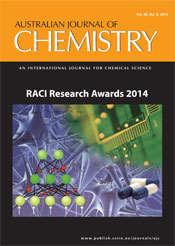
Australian Journal of Chemistry
Volume 68 Number 8 2015
RESEARCH FRONT: RACI Research Awards 2014
Papers authored by RACI awardees from 2014 are presented.
CH15172Adrien Albert Award: How to Mine Chemistry Space for New Drugs and Biomedical Therapies
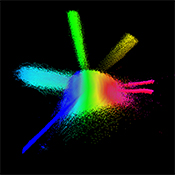
We describe how recent developments in mathematics have catalysed the development of robust computational modelling tools for exploring large chemical spaces, for extracting meaning from large datasets, for designing bioactive agents and materials, and for making predictive, quantitative models of molecular and materials properties for medicinal and regenerative medicine applications.
CH15340The Palladium-Catalysed Intramolecular Alder-ene (IMAE) Reactions of Certain Heteroatom-Linked 1,6-Enynes: The Formation of Hexahydro-Indoles and -Benzofurans
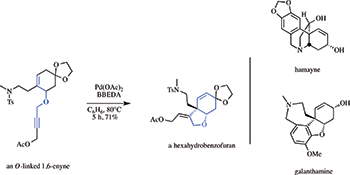
The application of PdII-catalysed intramolecular Alder-ene (IMAE) reactions of C-, N-, and O-linked 1,6-enynes to the preparation of various carbo- and hetero-cyclic compounds is discussed. Total syntheses of the alkaloids hamayne and galanthamine using these types of processes are outlined.
CH15206Alkali Metal Hydride Complexes: Well-Defined Molecular Species of Saline Hydrides
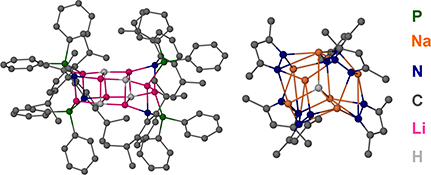
This review highlights the recent advances in the chemistry of well-defined alkali metal hydride complexes including their syntheses, structures, and properties. These soluble complexes have been obtained via β-hydride elimination or metathesis reactions, and show a higher reactivity compared with their parent ionic metal hydrides.
CH15313The Importance of Motions that Accompany Those Occurring Along the Reaction Coordinate
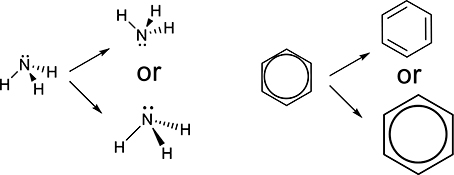
The ammonia inversion reaction is a torsional motion, but it also involves changing NH bond lengths. Analogously, the Kekulé motion of benzene interchanges two (hypothetical) local structures, but the CH lengths vary during the interchange. Alas spectroscopy tells us mostly about the NH and CH stretches, not the isomerization motions. This effect is general: what is important, and what spectroscopy has to tell, may be quite different things.
CH15191Electrochemical Restructuring of Copper Surfaces Using Organic Additives and Its Effect on the Electrocatalytic Reduction of Nitrate Ions
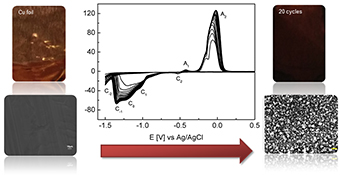
A simple electrochemical procedure is introduced to restructure a copper electrode into an active material for the electrocatalytic reduction of nitrate ions. The introduction of additives, such as benzyl alcohol and phenylacetic acid, into the alkaline electrolyte during the oxidation and reduction processes for restructuring copper significantly influences oxide formation and reduction. This is important for modifying the final morphology as well as the creation of surface active sites.
CH15298Chemistry of the Synthetic Strigolactone Mimic GR24
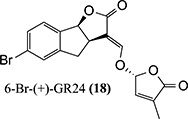
A second-generation, enantioselective synthesis of (+)-GR24 is described, alongside a novel bromo-GR24 analogue. In addition, the optimal solvent for making GR24 stock solutions is identified.
CH15298 Abstract | CH15298 Full Text | CH15298PDF (605 KB) | CH15298Supplementary Material (1002 KB)
CH15310Investigation of Roughness Periodicity on the Hydrophobic Properties of Surfaces
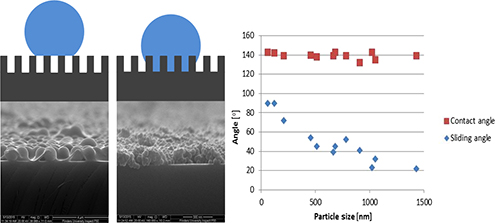
Hydrophobic films were synthesized with a variety of silica particle sizes to investigate the effect of particle size on the contact and sliding angles of water droplets. It was found that the sliding angle has a strong correlation with the roughness periodicity of the surface, whereas the water contact angle is mostly unaffected.
CH15234Acetylenes from Aldehydes. Preparation of Ethynylphenols and Phenylacetylenes by Flash Vacuum Pyrolysis of Isoxazolones
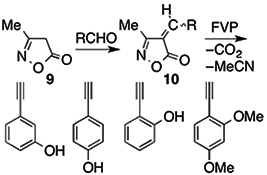
Arylacetylenes are synthesized from aldehydes 9 via isoxazolones 10 by flash vacuum pyrolysis. This includes kinetically unstable, sensitive compounds such as the ethynylphenols reported here.
CH14639Aromatic Schiff Bases Multiply Substituted with Terminal Ethynyl Groups: Potential Building Blocks for Conjugated Polymers and Oligomers
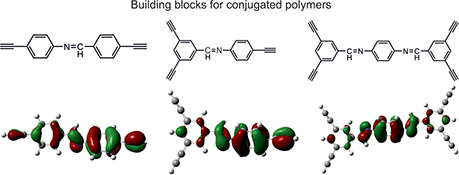
Nine mostly novel aromatic Schiff bases containing from two-to-four terminal ethynyl groups and one or two methanimine groups per one molecule are reported. The applicability of compounds as building blocks for conjugated polymers is shown.
CH14554Using Carbon Quantum Dots as Selective Photoluminescent Probes for Protein Kinase Assay
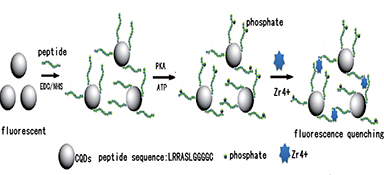
Schematic illustration of the PKA kinase assay based on the aggregation and fluorescence quenching of peptide–carbon quantum dots via Zr4+ ion linkage.
CH14579Phase Behaviours of Polybutadiene–Polyacrylic Acid Brushes in Compressed Carbon Dioxide
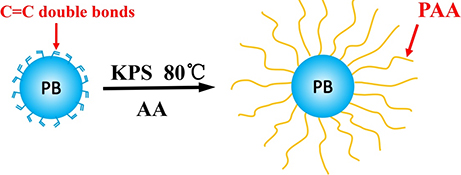
In this paper, we report a novel, environmentally friendly method to separate and recover spherical polyelectrolyte brushes (SPBs). Adjusting CO2 pressure could regulate the size and some other properties of SPB. Combined temperature quenching followed by depressurization led to the precipitation of SPB.
CH14613Synthesis, Structure, and Characterisation of Two New Open-Framework Zinc Phosphites of Varying Dimensionality
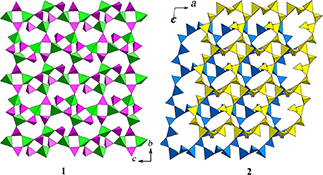
Two new zinc phosphites, [H2hpip][Zn2(HPO3)3] (1) and [H2hpip][Zn3(HPO3)4] (2) (hpip = homopiperazine), have been synthesised by adjusting synthetic conditions. Compound 1 displays a 2D layered structure with 8-membered ring apertures, and 2 possesses a (3,4)-connected 3D architecture with intersecting 8- and 12-ring channels.
CH14634Visible Light-Driven BiVO4/TiO2 Composite Photocatalysts: Preparation Methods and Photocatalytic Performance
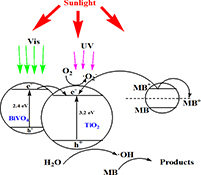
BiVO4/TiO2 composite photocatalysts were successfully synthesised and their physical and photophysical properties were fully characterised. BiVO4/TiO2 photocatalysts fabricated by different methods exhibit higher photocatalytic activities than pure BiVO4 and TiO2, and the coprecipitated BiVO4/TiO2 composite presents the best photocatalytic activity.
CH14670Preparation of Uniform Poly (Acrylamide-co-DVB) Microspheres in a Low Toxicity Solvent by Dispersion Polymerization
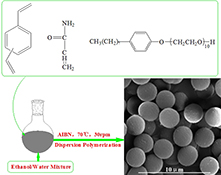
Uniform poly (acrylamide-co-DVB) microspheres (DVB = divinylbenzene) with number-average diameter varying from 1.65 to 2.86μm, polydispersity index from 1.011 to 1.176 were prepared in a low toxicity solvent, i.e. ethanol/water mixtures, by dispersion polymerization using octylphenol polyoxyethylene (10) ether as the stabilizer and 2,2′-azobisisobutyronitrile as the initiator. The yield of the uniform microspheres could be up to ~35 % by changing the conditions moderately.
CH14726Synthesis and Oxidative Desulfurization of PV-Functionalized Imidazole-2-thiones: Easy Access to P-Functional Ionic Liquids

A series of backbone phosphanoyl group substituted imidazole-2-thiones were synthesized by low temperature lithiation and phosphanylation. Oxidative desulfurization of the imidazole-2-thiones afforded backbone phosphanoyl functionalized imidazolium ionic liquids. New entry to imidazolium ionic liquids with short chains on nitrogens of the imidazolium rings was affected via asymmetric backbone functionalization.
CH14642Facile Refluxing Synthesis of Hydroxyapatite Nanoparticles
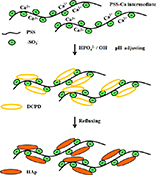
An effective synthesis of hydroxyapatite nanoparticles via a facile environmentally friendly refluxing route has been proposed. Furthermore, a non-toxic, water-soluble anionic polyelectrolyte, i.e. polystyrene sulfonate, was introduced into the refluxing system in order to control growth direction of hydroxyapatite. The rod-shaped hydroxyapatite nanoparticles with positive surface charge were obtained.
CH14669Urothermal Syntheses, Crystal Structures, and Luminescent Properties of Two New ZnII Compounds Constructed by the Mixed Ligands of 1,2,4-Triazole and 1,4-Naphthalenedicarboxylic Acid or 2,6-Naphthalenedicarboxylic Acid
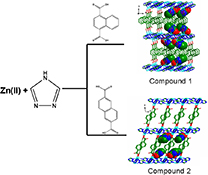
Two new coordination polymers, namely [Zn(1,4-ndc)0.5(taz)]n·n(e-urea) (1) and [Zn(2,6-ndc)0.5(taz)]n·n(H2O)·n(e-urea) (2) have been successfully synthesised by using 1,2,4-triazole and dicarboxylate ligands under urothermal conditions. Both compounds 1 and 2 feature 3D pillar-layered frameworks with 6-connected pcu topologies.
CH14675Zero-Valent Iron Nanoparticles (NZVI) Supported by Kaolinite for CuII and NiII Ion Removal by Adsorption: Kinetics, Thermodynamics, and Mechanism

Kaolinite is a suitable material for use as a skeleton to hold zero-valent iron nanoparticles (nZVI) together. Synthesized nZVI-Kaolinite was used to adsorb CuII and NiII, as representative models of metal ions. The possible removal mechanisms involved redox, adsorption, precipitation, and co-precipitation, depending on the adsorption process studied (CuII or NiII adsorption).



